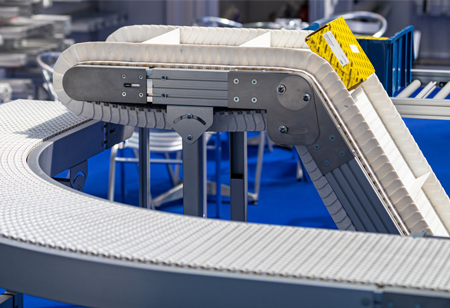
Conveyor belt systems are integral to material handling in many industries. Ensuring these systems operate at peak efficiency with stringent safety standards is critical for maintaining productivity.
Here are proven strategies to improve conveyor performance while guarding against preventable accidents and injuries.
Customize Conveyor Belt Selection and Composition
Selecting the right conveyor belt, tailored to your operational needs, is vital for system efficiency and longevity. Partnering with manufacturers re- cognized for high-quality conveyor belt construction offers significant advantages. Such collaboration ensures materials and designs meet your specific requirements, striking a balance between durability and perfor- mance.
These customized solutions equip your conveyor system to manage its workload efficiently with reduced wear, extending its lifespan.
Upgrade Motors and Transmissions To High-Efficiency Units
Purchasing high-efficiency conveyor components is a strategic move that yields substantial energy savings and cost reductions. By upgrading to premium efficiency motors suited to your specific load requirements, you can achieve substantial cost savings.
Furthermore, switching to smooth, high-torque transmissions and mechanical drives significantly diminishes friction losses, out- performing standard units in both efficiency and longevity.
Implement Proper Guarding and Safety Curtains
Worker safety around conveyors is crucial, as access points often present risks of entanglement, pinching, and other serious injuries. By installing comprehensive guarding solutions, including fixed barriers, removable guards, and safety curtains, you can mitigate these dangers.
It's imperative that these measures adhere to all relevant regulations and standards to provide effective protection for your personnel.
Optimize Idler Roller Design and Spacing
The performance of conveyor belts heavily depends on the design and spacing of idler rollers. By optimizing these elements, you can prevent issues like sagging and bouncing under heavy loads, which directly translates to smoother operations and increased efficiency. Configuring idler rollers to be closer in stations where the load is heavier and selecting the right profiles, materials, and coatings maximizes belt support, reducing both friction and wear.
Additionally, ensuring idler rollers are precisely aligned prevents belt mistracking, further enhancing the conveyor's reliability.
Tighten Transfer Points and Adjust Loading Zones
Efficient management of transfer points and loading zones is crucial for minimizing product spillage and ensuring smooth transitions between conveyors. By maintaining minimal gaps at these critical junctures, you can reduce the risk of spillage and accumulation that can impede conveyor efficiency. Adjusting material loading zones to distribute the load evenly across the belt width is essential for optimal performance.
Implementing robust side guarding further secures the product within the confines of the belt, minimizing loss and enhancing overall system efficiency.
Stabilize Frame and Support Structures Against Vibration
Continuous operation can lead to vibrations that gradually undermine the stability of conveyor frames, supports, and structures, affecting alignment and efficiency. Addressing this challenge requires reinforcing these elements with sturdy cross-bracing designed to absorb and dampen vibrations, thereby maintaining correct belt tracking.
The use of precision-machined feet and secure anchor bolts offers a reliable alternative to makeshift solutions. It provides a stable base that counters the effects of flexing and swaying.
Conduct Regular Belt Inspections and Maintenance
The longevity and efficiency of conveyor systems are heavily dependent on regular and thorough belt inspections and maintenance. Establishing a routine schedule for these inspections along the entire length of the belt is imperative.
This proactive approach facilitates the early detection of potential issues such as wear, fraying, belt misalignment, or damage to idlers and rollers. Immediate corrective action on splicing, tracking, or tensioning issues can prevent undue stress on the belt and its components.
Install Advanced Monitoring and Sensors
Elevate your conveyor system's reliability with advanced sensor technology to monitor critical parameters such as belt tension, speed, alignment, temperatures, and vibration. These integrated sensors offer real-time insights, tracking these parameters and issuing alerts for deviations from standard performance metrics, allowing for immediate intervention.
This level of monitoring supports a predictive maintenance strategy, identifying potential issues before they escalate into costly downtime or hazardous situations.
 Incorporate Energy-Efficient Conveyor Accessories
Incorporate Energy-Efficient Conveyor Accessories
Adopting energy-efficient accessories can significantly reduce operational costs. Translucent capping, for instance, lowers lighting expenses by utilizing natural light. On the other hand, the strategic placement of scrapers, skirting, and wind guards reduces airflow resistance, enhancing the efficiency of overland conveyors.
Additionally, installing motion sensors in conveyor galleries automates lighting, further cutting energy consumption.
Promote Cleanliness To Minimize Downtime
Maintaining cleanliness in conveyor systems is essential for operational efficiency, not just appearance. Accumulated debris adds resistance and weight, increasing energy consumption. Regular cleaning protocols and swift removal of spillage and residues from components like idlers, pulleys, and motors can minimize system strain.
This dedication to cleanliness enhances efficiency and decreases downtime risks.
Wrapping Up
Adopting proactive maintenance, incorporating high-efficiency components, and refining system designs are significant steps toward optimizing conveyor belt systems for reliable performance and enhanced safety. The addition of rigorous monitoring and preventative measures further guarantees sustained peak operations.
Together, these strategies ensure the smooth functioning of conveyor systems and bolster the efficiency and profitability of modern industrial operations.
We use cookies to ensure you get the best experience on our website. Read more...